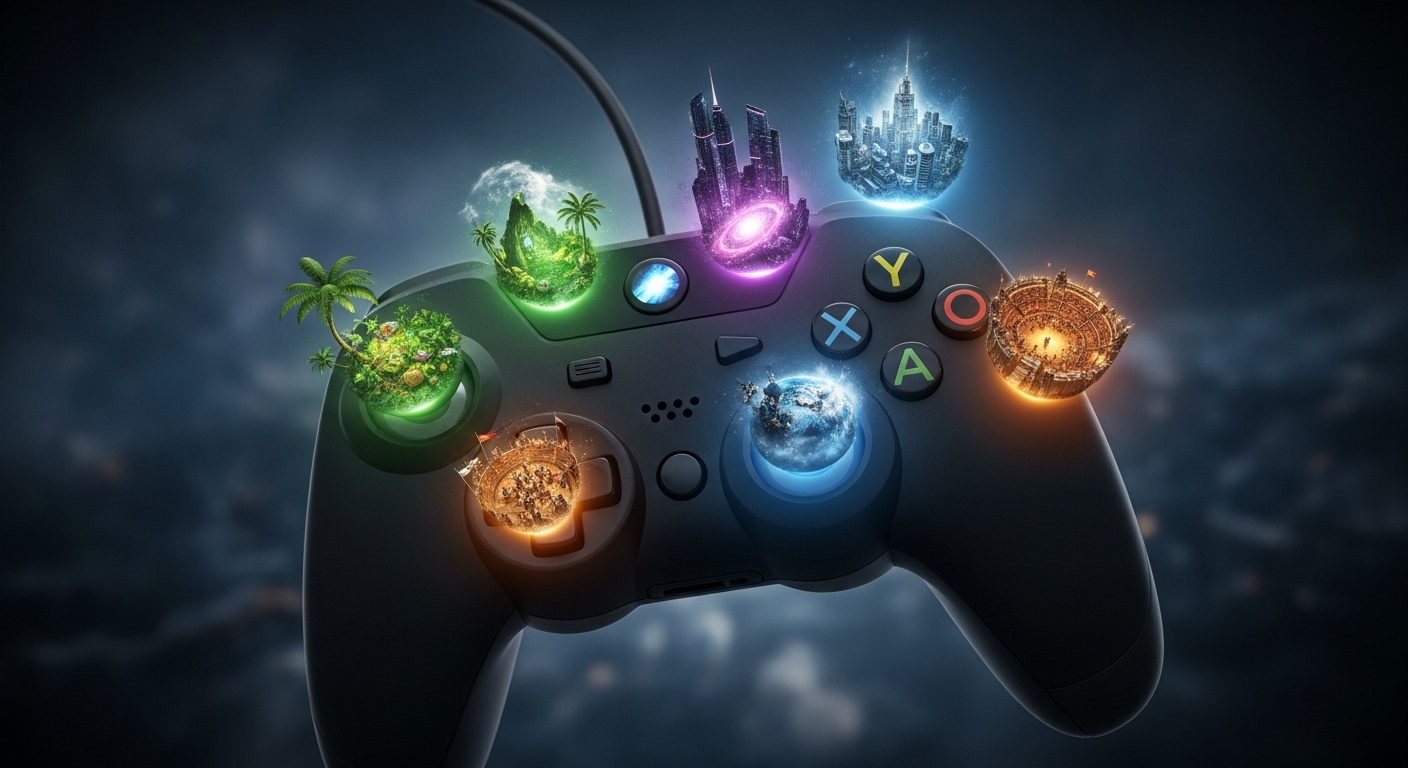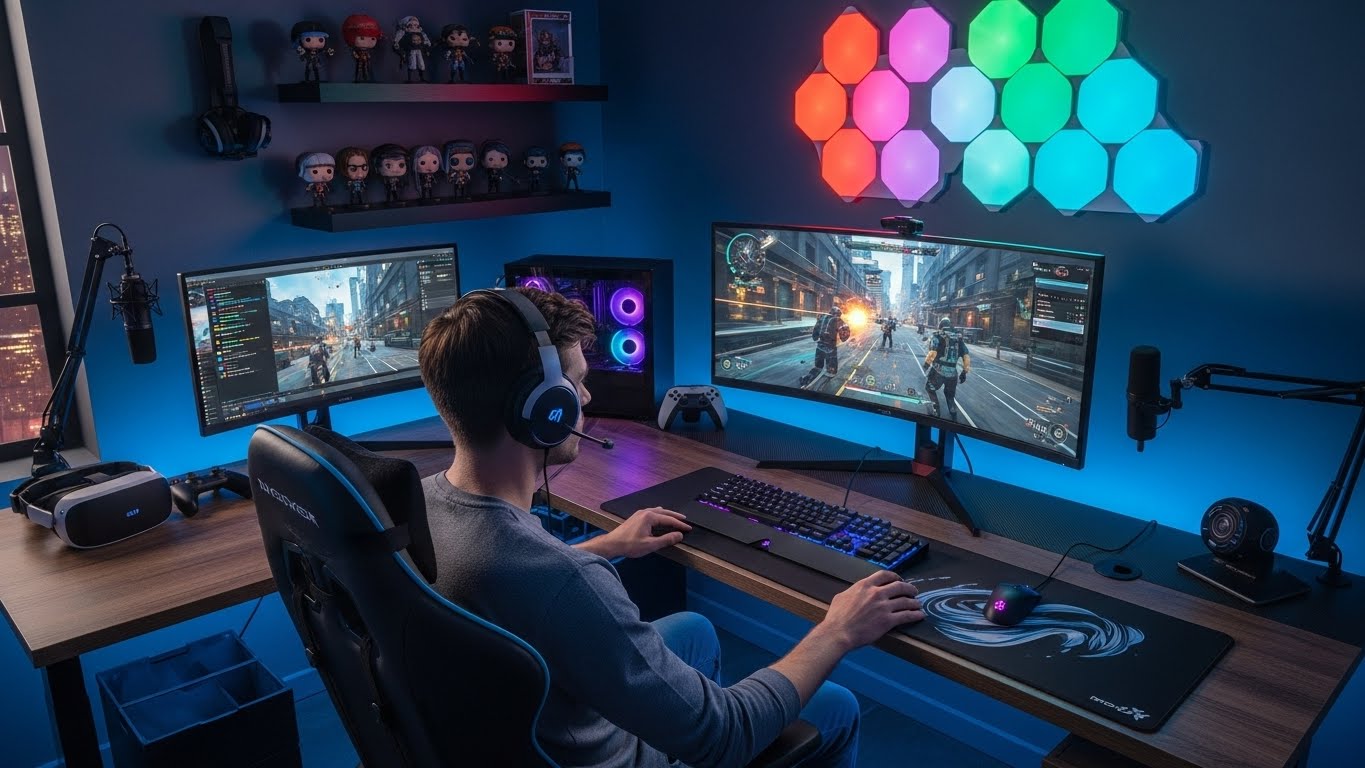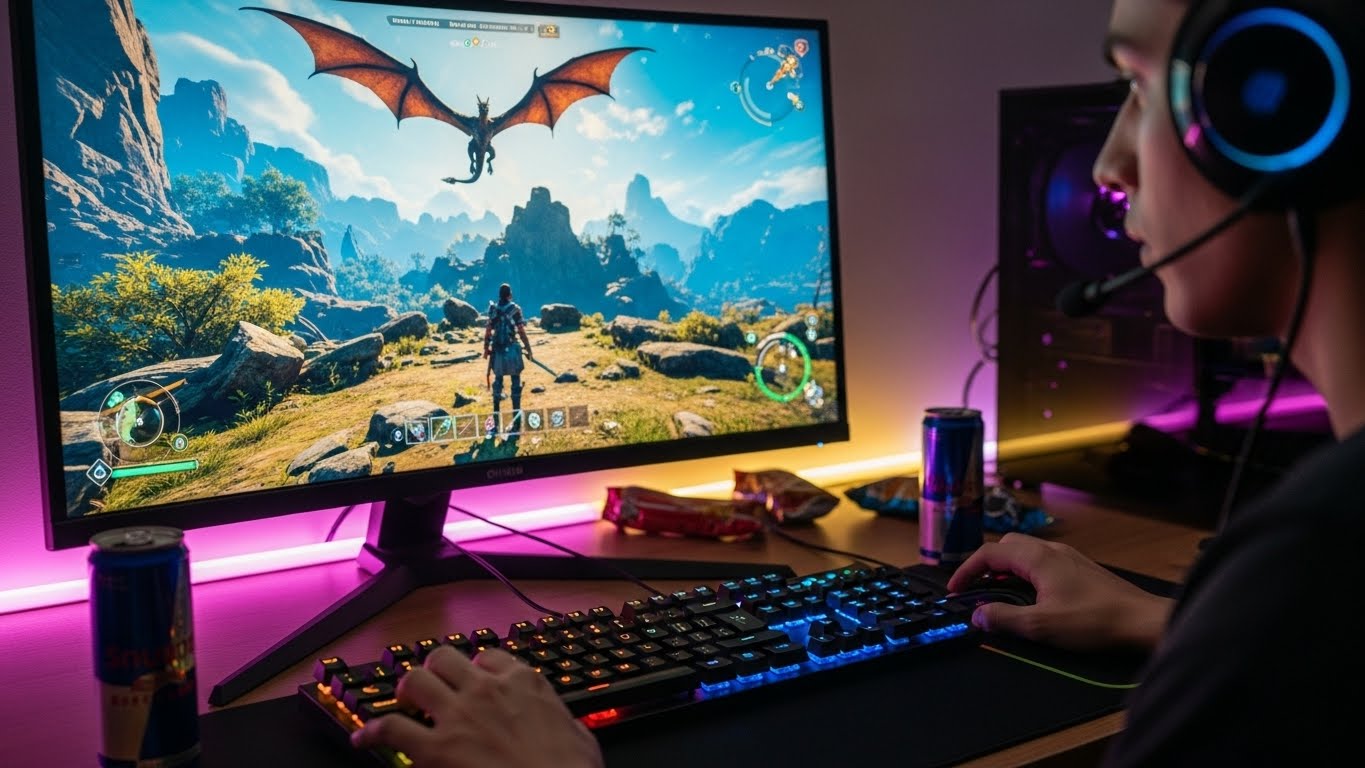Gaming has become one of the most influential aspects of modern culture. From humble beginnings in dimly lit arcades and pixelated home consoles to the sprawling virtual universes of today, gaming has transformed into an art form, a sport, and a social network all at once. It is no longer confined to the boundaries of entertainment; it is a force that drives technology, storytelling, education, and even human connection.
This is the story of gaming — where it came from, how it evolved, and where it is going in the digital future.
The Origins: When Gaming Was Simple Yet Revolutionary
To understand gaming today, we must look back at its roots. In the early 1970s, video games were experiments rather than products. Games like Pong, Spacewar!, and Breakout represented a new way of engaging with technology. They were simple, built on basic graphics and mechanics, yet they sparked something profound — the idea that computers could be fun.
In arcades, players lined up with coins in hand to experience this new kind of entertainment. Each flashing screen became a window into a different world. The excitement of competing for high scores turned arcades into community centers for a new generation. These early experiences built the foundation for what gaming would become: interactive, social, and endlessly creative.
The introduction of home consoles like the Atari 2600 brought gaming into living rooms. For the first time, players could enjoy their favorite titles without leaving home. This transition from public arcades to private homes marked a pivotal shift — gaming was no longer a novelty, it was a lifestyle.
The 8-Bit and 16-Bit Eras: The Rise of Icons and Innovation
The 1980s ushered in what many call the golden age of gaming. Companies like Nintendo and Sega became household names, and their consoles defined an era. The Nintendo Entertainment System (NES) introduced iconic characters like Mario, Link, and Samus, while Sega’s Genesis brought fast-paced, attitude-driven heroes like Sonic the Hedgehog to life.
These decades were filled with experimentation. Game developers began exploring storytelling, atmosphere, and gameplay variety. Titles like The Legend of Zelda, Final Fantasy, and Metroid laid the groundwork for modern gaming genres. Side-scrolling platformers, role-playing games, and adventure titles became beloved staples of the medium.
The graphics were simple, but imagination filled in the gaps. Each pixel carried emotion, each beep of music carried tension or joy. Gamers weren’t just playing; they were creating memories that would last a lifetime. The 8-bit and 16-bit eras defined the language of gaming — clear rules, creativity within limits, and the pure thrill of play.
The 3D Revolution: Stepping Into New Dimensions
The mid-1990s brought one of the most transformative changes in gaming history — the jump to three dimensions. The advent of 3D graphics technology allowed developers to create fully realized worlds. Suddenly, players could move freely, explore vast environments, and experience narratives in cinematic ways.
Sony’s PlayStation, Nintendo 64, and later the Sega Dreamcast introduced experiences that felt alive. Super Mario 64 demonstrated how movement and perspective could revolutionize gameplay. Tomb Raider gave players control over a daring adventurer in a realistic world. Final Fantasy VII showed that games could tell deep emotional stories with complex characters.
With better hardware came bigger ambitions. Developers began to think like filmmakers, composers, and writers. Soundtracks became symphonic, voice acting became standard, and storylines reached new depths. Gaming was no longer just about reaction and reflex — it was about emotion, imagination, and immersion.
The Online Age: Connecting Players Across the World
As the new millennium approached, another transformation reshaped the gaming landscape — the rise of the internet. Online multiplayer gaming changed the way people interacted with their favorite titles and with each other. Games like Counter-Strike, World of Warcraft, and Halo 2 connected millions of players worldwide, forming communities that transcended geography and culture.
The internet turned gaming from a solitary or local activity into a global phenomenon. Clans, guilds, and online friendships became part of everyday life. Competitive gaming, once a niche, evolved into organized tournaments and eventually the massive world of esports. Players weren’t just competing for fun anymore — they were competing for fame and fortune.
This online revolution also introduced new forms of creativity. Modding communities began to flourish, allowing fans to reshape and reinvent their favorite games. The rise of user-generated content gave players the power to become developers themselves. Gaming had become not just a product to consume but a platform to build upon.
The Era of High Definition: Cinematic Experiences and Realism
By the late 2000s and 2010s, gaming had entered its most visually stunning era yet. High-definition graphics, advanced physics, and realistic animations blurred the line between game and film. Consoles like the PlayStation 3, Xbox 360, and powerful gaming PCs brought movie-quality experiences to life.
Titles such as Uncharted, The Last of Us, and Mass Effect pushed storytelling to new heights. They explored human emotion, morality, and consequence through interactive storytelling. Each decision felt meaningful, and each scene was crafted with cinematic precision.
Meanwhile, open-world games became the dominant trend. Players could now explore vast, detailed worlds filled with freedom and discovery. Games like Skyrim, Grand Theft Auto V, and The Witcher 3 redefined what it meant to have an immersive experience. No longer confined to linear paths, players could shape their journeys however they wished.
The combination of narrative depth and graphical realism elevated gaming to an art form. Developers began to be recognized as storytellers and artists, not just programmers. Gaming had matured — it was no longer for children or hobbyists alone; it had become a mainstream cultural powerhouse.
The Psychology of Gaming: Why We Play
To understand why gaming has such a powerful hold on people, we must look at the psychology behind play. Gaming satisfies some of humanity’s most fundamental needs — exploration, mastery, competition, and connection.
At its core, gaming provides a sense of achievement. Each challenge overcome, each level completed, each victory earned feeds the human desire for progress. Unlike many aspects of life, games offer immediate feedback and a clear path to improvement. They provide structure, purpose, and reward.
Gaming also fulfills a social need. Online games and multiplayer experiences allow people to bond, collaborate, and communicate across boundaries. Friendships formed through gaming often last years, proving that virtual interaction can be as meaningful as face-to-face conversation.
Moreover, gaming offers escapism — a way to step outside of reality for a while and experience something extraordinary. In times of stress or uncertainty, games can be both comforting and empowering. They give players agency in worlds where they can control outcomes, unlike the unpredictability of real life.
The Rise of Esports: When Play Became Profession
What was once considered a pastime has now become a global sport. Esports, or competitive gaming, has exploded in popularity. Professional players, teams, and leagues now exist for nearly every major competitive title. Games like League of Legends, Dota 2, Valorant, and Counter-Strike draw millions of viewers and offer prize pools that rival traditional sports tournaments.
Esports athletes train with discipline and precision, practicing for hours each day. Their reflexes, strategies, and teamwork are honed to perfection. Tournaments are broadcast to millions of fans, complete with commentators, analysts, and sponsorships.
This professionalization of gaming has legitimized it in the eyes of the world. Universities now offer esports scholarships. Brands sponsor teams. Stadiums fill with cheering fans watching digital athletes compete. Gaming has proven that skill, dedication, and teamwork in the virtual world are as real and respected as in any physical sport.
The Indie Game Renaissance: Creativity Beyond Limits
While big-budget studios continue to push technical boundaries, the rise of independent game developers has sparked a creative revolution. Indie games, often created by small teams or even single individuals, have brought fresh ideas and emotional storytelling to the forefront.
Titles like Undertale, Celeste, Hades, and Stardew Valley prove that a game doesn’t need massive budgets to make an impact. These games often focus on innovation, personal storytelling, and unique artistic expression. They explore themes of identity, love, struggle, and hope in ways that massive franchises sometimes can’t.
Digital distribution and platforms that support indie development have democratized game creation. Anyone with talent and passion can now bring their vision to life and reach a global audience. This freedom has led to some of the most creative and heartfelt experiences in gaming history.
The Role of Streaming and Content Creation
In the last decade, another phenomenon has reshaped gaming culture — the rise of live streaming and content creation. Platforms that allow gamers to broadcast their gameplay and commentary have turned players into entertainers, educators, and influencers.
Streamers share their experiences in real-time, building communities around their personalities. Viewers tune in not only for the games but for the people playing them. This new form of entertainment blends gaming with performance art, storytelling, and social connection.
Content creation has also given rise to new careers. Many gamers now earn a living by sharing their gameplay, tutorials, and insights. They have become cultural icons, shaping trends and introducing new audiences to the world of gaming.
This era of streaming has made gaming more inclusive, interactive, and social than ever before. It has turned the act of playing into a shared global experience.
The Technological Frontier: Virtual Reality and Beyond
Gaming has always been driven by innovation, and the next frontier lies in immersion. Virtual reality (VR) and augmented reality (AR) are transforming how players experience digital worlds. With VR headsets, players can step inside games, look around, and interact with environments in lifelike ways.
VR titles like Half-Life: Alyx, Beat Saber, and No Man’s Sky VR show the potential of this technology. AR, on the other hand, blends digital elements with the real world, as seen in games that overlay virtual creatures or objects onto real environments.
Meanwhile, advancements in artificial intelligence are making games smarter and more adaptive. Non-player characters now respond dynamically to player actions, creating experiences that feel unique to each individual. Cloud gaming is also breaking barriers, allowing people to play high-end games on any device without expensive hardware.
The future of gaming is not just about better graphics or faster processors; it’s about deeper immersion, interactivity, and personalization.
Gaming as Art and Storytelling
Today, gaming is widely recognized as a legitimate form of art. It combines visuals, music, narrative, and interactivity to create experiences that evoke emotion and thought. Games like Journey, The Last of Us Part II, and Inside are not just entertainment — they are emotional journeys that explore the human condition.
Unlike movies or books, games give players agency. The player is not merely an observer but a participant in the story. Each choice, each action, influences the outcome, creating a sense of personal investment. This interactivity makes gaming one of the most powerful storytelling mediums of the modern age.
Artists, writers, and musicians now collaborate with game developers to create works that push boundaries. The result is a medium capable of both blockbuster spectacle and intimate poetry.
The Social and Cultural Impact of Gaming
Gaming is no longer a subculture; it is a global culture. It influences fashion, music, language, and even politics. Game soundtracks are performed in concert halls, characters appear in movies and advertisements, and gaming slang has entered everyday speech.
Moreover, gaming communities have become platforms for activism, charity, and social awareness. Events like charity marathons and in-game fundraisers have raised millions for good causes. Games also foster understanding by placing players in the shoes of others, promoting empathy through experience.
Gaming has also challenged stereotypes. The notion that games are only for children or certain demographics has faded. People of all ages, backgrounds, and identities now share the love of play. Inclusivity and representation have become essential aspects of modern game design, ensuring that everyone can see themselves reflected in the worlds they explore.
Challenges in the Gaming World
Despite its achievements, gaming faces its share of challenges. Issues such as toxicity in online communities, crunch culture in game development, and concerns about addiction and mental health continue to spark debate.
Developers and players alike are now pushing for healthier practices. Many companies are addressing workplace ethics, representation, and player well-being. Awareness of balance — both in gameplay and development — is growing, leading to a more sustainable and inclusive future for the industry.
The Future of Gaming: Infinite Horizons
As we look ahead, the possibilities for gaming seem limitless. Artificial intelligence, cloud technology, and quantum computing could redefine how games are created and played. Entirely procedural worlds, personalized storytelling, and cross-reality experiences are on the horizon.
The boundaries between gaming and other media continue to blur. Interactive films, educational simulations, and gamified social experiences are expanding what gaming can be. In the near future, gaming may become the central hub for entertainment, learning, and creativity.
What remains constant, however, is the spirit of play — the joy of exploration, the thrill of challenge, and the sense of connection that gaming brings.
Conclusion: More Than Just a Game
From the arcades of the past to the virtual universes of today, gaming has always been about more than pixels and scores. It is about imagination, innovation, and human connection. It reflects our creativity and our desire to explore new worlds, both real and imagined.
Gaming has evolved into a language of its own — a language that transcends barriers, speaks to emotion, and inspires generations. Whether you play for competition, for art, for escape, or for friendship, you are part of a global story that continues to grow and evolve.
The world of gaming is vast, diverse, and ever-changing. And as technology advances, one thing remains certain — the game is far from over. It’s only just beginning.



